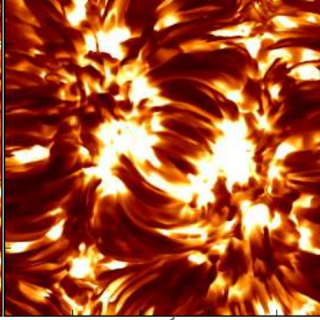Bibcode
Janett, Gioele; Ballester, Ernest Alsina; Guerreiro, Nuno; Riva, Simone; Belluzzi, Luca; del Pino Alemán, Tanausú; Trujillo Bueno, Javier
Bibliographical reference
Astronomy and Astrophysics
Advertised on:
11
2021
Journal
Citations
17
Refereed citations
17
Description
Context. The correct modeling of the scattering polarization signals observed in several strong resonance lines requires taking partial frequency redistribution (PRD) phenomena into account. Modeling scattering polarization with PRD effects is very computationally demanding and the simplifying angle-averaged (AA) approximation is therefore commonly applied.
Aims: This work aims to assess the impact and the range of validity of the AA approximation with respect to the general angle-dependent (AD) treatment of PRD effects in the modeling of scattering polarization in strong resonance lines, with a focus on the solar Ca I 4227 Å line.
Methods: Spectral line polarization was modeled by solving the radiative transfer problem for polarized radiation, under nonlocal thermodynamic equilibrium conditions, taking PRD effects into account in static one-dimensional semi-empirical atmospheric models presenting arbitrary magnetic fields. The problem was solved through a two-step approach. In step 1, the problem was solved for the intensity only, considering a multilevel atom. In step 2, the problem was solved including polarization, considering a two-level atom with an unpolarized and infinitely sharp lower level, and fixing the lower level population calculated at step 1.
Results: The results for the Ca I 4227 Å line show a good agreement between the AA and AD calculations for the Q/I and U/I wings' signals. However, AA calculations reveal an artificial trough in the line-core peak of the linear polarization profiles, whereas AD calculations show a sharper peak in agreement with the observations.
Conclusions: An AD treatment of PRD effects is essential to correctly model the line-core peak of the scattering polarization signal of the Ca I 4227 Å line. By contrast, in the considered static case, the AA approximation seems to be suitable to model the wing scattering polarization lobes and their magnetic sensitivity through magneto-optical effects.
Aims: This work aims to assess the impact and the range of validity of the AA approximation with respect to the general angle-dependent (AD) treatment of PRD effects in the modeling of scattering polarization in strong resonance lines, with a focus on the solar Ca I 4227 Å line.
Methods: Spectral line polarization was modeled by solving the radiative transfer problem for polarized radiation, under nonlocal thermodynamic equilibrium conditions, taking PRD effects into account in static one-dimensional semi-empirical atmospheric models presenting arbitrary magnetic fields. The problem was solved through a two-step approach. In step 1, the problem was solved for the intensity only, considering a multilevel atom. In step 2, the problem was solved including polarization, considering a two-level atom with an unpolarized and infinitely sharp lower level, and fixing the lower level population calculated at step 1.
Results: The results for the Ca I 4227 Å line show a good agreement between the AA and AD calculations for the Q/I and U/I wings' signals. However, AA calculations reveal an artificial trough in the line-core peak of the linear polarization profiles, whereas AD calculations show a sharper peak in agreement with the observations.
Conclusions: An AD treatment of PRD effects is essential to correctly model the line-core peak of the scattering polarization signal of the Ca I 4227 Å line. By contrast, in the considered static case, the AA approximation seems to be suitable to model the wing scattering polarization lobes and their magnetic sensitivity through magneto-optical effects.
Related projects

Magnetism, Polarization and Radiative Transfer in Astrophysics
Magnetic fields pervade all astrophysical plasmas and govern most of the variability in the Universe at intermediate time scales. They are present in stars across the whole Hertzsprung-Russell diagram, in galaxies, and even perhaps in the intergalactic medium. Polarized light provides the most reliable source of information at our disposal for the
Ernest
Alsina Ballester